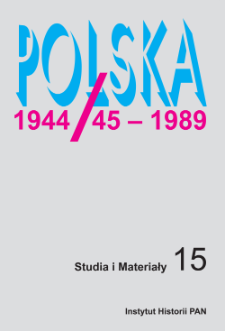- Wyszukaj w całym Repozytorium
- Piśmiennictwo i mapy
- Archeologia
- Baza Młynów
- Nauki przyrodnicze
Wyszukiwanie zaawansowane
Wyszukiwanie zaawansowane
Wyszukiwanie zaawansowane
Wyszukiwanie zaawansowane
Wyszukiwanie zaawansowane

Obiekt
Tytuł: Prawno-społeczna pozycja felczera w Polsce w latach 1945–1989
Inny tytuł:
Polska 1944/45-1989 : studia i materiały 15 (2017)
Współtwórca:
Instytut Historii Polskiej Akademii Nauk
Wydawca:
Instytut Historii Polskiej Akademii Nauk
Miejsce wydania:
Opis:
s. 127-148 : il. ; Streszcz. w jęz. angielskim ; Dofinansowano ze środków Ministra Nauki i Szkolnictwa Wyższego
Typ obiektu:
Abstrakt:
Okres po II wojnie światowej, cechujący się na gruncie medycznym powszechnym brakiem kadry lekarskiej oraz pielęgniarskiej, jak też zniszczeniem infrastruktury i zaplecza medycznego, wymuszał wprowadzenie szybkich rozwiązań gwarantujących, przynajmniej na minimalnym poziomie, opiekę nad społeczeństwem. Wykształcenie stosownego personelu wymagało odpowiedniej ilości czasu. W tej sytuacji ówczesna władza zastosowała istniejące, aczkolwiek już zapomniane rozwiązanie, w postaci zawodu felczera – cechującego się pewną samodzielnością w wykonywaniu prostych czynności medycznych. Celem niniejszej publikacji jest przybliżenie zakresu uprawnień, jakie przysługiwały felczerowi w nowej rzeczywistości politycznej, określenie, w jaki sposób ten zawód był wówczas postrzegany.
Bibliografia:
Bukowska A., Organizacje felczerów w Polsce w pierwszej połowie XX wieku, w: Zawody diagnosty laboratoryjnego i felczera na ziemiach polskich w XIX i XX wieku, red. B. Urbanek, Warszawa 2011
Karkowska D., Włodarczyk W., Prawo medyczne dla pielęgniarek, Warszawa 2013
Lipińska M., Średnie szkolnictwo felczerskie w opinii tygodnika „Służba Zdrowia”, w: Zawody diagnosty laboratoryjnego i felczera na ziemiach polskich w XIX i XX wieku, red. B. Urbanek, Warszawa 2011
Lipińska M., Niespełnione obietnice, czyli walka felczerów o przetrwanie w opinii prasy zawodowej w latach 1949 – 1961, w: Zawody diagnosty laboratoryjnego i felczera na ziemiach polskich w XIX i XX wieku, red. B. Urbanek, Warszawa 2011
Marcysiak M., Uprawienia felczerów w Polsce okresu międzywojennego w świetle „Przeglądu Felczerskiego”, w: Zawody diagnosty laboratoryjnego i felczera na ziemiach polskich w XIX i XX wieku, red. B. Urbanek, Warszawa 2011
Marek A., XIXi XX-wieczne podręczniki dla felczerów, w: Zawody diagnosty laboratoryjnego i felczera na ziemiach polskich w XIX i XX wieku, red. B. Urbanek, Warszawa 2011
Królikowski J., Generałowie i admirałowie Wojska Polskiego 1943–1990, Toruń 2010
Popielski B., Medycyna i prawo, Warszawa 1963 http://www.nil.org.pl/rejestry/centralny-rejestr-felczerow
http://www.gazetaprawna.pl/artykuly/867747,najmlodszy-polski-felczer-to-biurokracja-jest- anachroniczna-a-nie-ja.html
Czasopismo/Seria/cykl:
Polska 1944/45-1989 : studia i materiały
Tom:
Strona pocz.:
Strona końc.:
Szczegółowy typ zasobu:
Format:
Identyfikator zasobu:
oai:rcin.org.pl:64920 ; 2450-8357 ; 10.12775/Polska.2017.07
Źródło:
IH PAN, sygn. B.155/15 Podr. ; IH PAN, sygn. B.156/15 ; kliknij tutaj, żeby przejść
Język:
Język streszczenia:
Prawa:
Licencja Creative Commons Uznanie autorstwa-Bez utworów zależnych 4.0
Zasady wykorzystania:
Zasób chroniony prawem autorskim. [CC BY-ND 4.0 Międzynarodowe] Korzystanie dozwolone zgodnie z licencją Creative Commons Uznanie autorstwa-Bez utworów zależnych 4.0, której pełne postanowienia dostępne są pod adresem: ; -
Digitalizacja:
Instytut Historii Polskiej Akademii Nauk
Lokalizacja oryginału:
Biblioteka Instytutu Historii PAN
Dostęp:
Kolekcje, do których przypisany jest obiekt:
- Digital Repository of Scientific Institutes > Partners' collections > Institute of History PAS > Serials
- Digital Repository of Scientific Institutes > Partners' collections > Institute of History PAS > Institute Publications
- Digital Repository of Scientific Institutes > Partners' collections > Institute of History PAS > Institute Publications > Journals
- Digital Repository of Scientific Institutes > Partners' collections > Institute of History PAS > Institute Publications > Journals > Polska 1944/45-1989
- Digital Repository of Scientific Institutes > Literature > Journals/Articles
Data ostatniej modyfikacji:
2 paź 2020
Data dodania obiektu:
6 mar 2018
Liczba pobrań / odtworzeń:
1735
Wszystkie dostępne wersje tego obiektu:
https://rcin.org.pl./publication/84243
Wyświetl opis w formacie RDF:
Wyświetl opis w formacie RDFa:
Wyświetl opis w formacie OAI-PMH:
| Nazwa wydania | Data |
|---|---|
| Fiktus, Paweł, Prawno-społeczna pozycja felczera w Polsce w latach 1945–1989 | 2 paź 2020 |
Obiekty Podobne
Kisiała, Wojciech
Grata, Paweł
Svobodný, Petr
Malczewski, Jacek

 INSTYTUT ARCHEOLOGII I ETNOLOGII POLSKIEJ AKADEMII NAUK
INSTYTUT ARCHEOLOGII I ETNOLOGII POLSKIEJ AKADEMII NAUK
 INSTYTUT BADAŃ LITERACKICH POLSKIEJ AKADEMII NAUK
INSTYTUT BADAŃ LITERACKICH POLSKIEJ AKADEMII NAUK
 INSTYTUT BADAWCZY LEŚNICTWA
INSTYTUT BADAWCZY LEŚNICTWA
 INSTYTUT BIOLOGII DOŚWIADCZALNEJ IM. MARCELEGO NENCKIEGO POLSKIEJ AKADEMII NAUK
INSTYTUT BIOLOGII DOŚWIADCZALNEJ IM. MARCELEGO NENCKIEGO POLSKIEJ AKADEMII NAUK
 INSTYTUT BIOLOGII SSAKÓW POLSKIEJ AKADEMII NAUK
INSTYTUT BIOLOGII SSAKÓW POLSKIEJ AKADEMII NAUK
 INSTYTUT CHEMII FIZYCZNEJ PAN
INSTYTUT CHEMII FIZYCZNEJ PAN
 INSTYTUT CHEMII ORGANICZNEJ PAN
INSTYTUT CHEMII ORGANICZNEJ PAN
 INSTYTUT FILOZOFII I SOCJOLOGII PAN
INSTYTUT FILOZOFII I SOCJOLOGII PAN
 INSTYTUT GEOGRAFII I PRZESTRZENNEGO ZAGOSPODAROWANIA PAN
INSTYTUT GEOGRAFII I PRZESTRZENNEGO ZAGOSPODAROWANIA PAN
 INSTYTUT HISTORII im. TADEUSZA MANTEUFFLA POLSKIEJ AKADEMII NAUK
INSTYTUT HISTORII im. TADEUSZA MANTEUFFLA POLSKIEJ AKADEMII NAUK
 INSTYTUT JĘZYKA POLSKIEGO POLSKIEJ AKADEMII NAUK
INSTYTUT JĘZYKA POLSKIEGO POLSKIEJ AKADEMII NAUK
 INSTYTUT MATEMATYCZNY PAN
INSTYTUT MATEMATYCZNY PAN
 INSTYTUT MEDYCYNY DOŚWIADCZALNEJ I KLINICZNEJ IM.MIROSŁAWA MOSSAKOWSKIEGO POLSKIEJ AKADEMII NAUK
INSTYTUT MEDYCYNY DOŚWIADCZALNEJ I KLINICZNEJ IM.MIROSŁAWA MOSSAKOWSKIEGO POLSKIEJ AKADEMII NAUK
 INSTYTUT PODSTAWOWYCH PROBLEMÓW TECHNIKI PAN
INSTYTUT PODSTAWOWYCH PROBLEMÓW TECHNIKI PAN
 INSTYTUT SLAWISTYKI PAN
INSTYTUT SLAWISTYKI PAN
 SIEĆ BADAWCZA ŁUKASIEWICZ - INSTYTUT TECHNOLOGII MATERIAŁÓW ELEKTRONICZNYCH
SIEĆ BADAWCZA ŁUKASIEWICZ - INSTYTUT TECHNOLOGII MATERIAŁÓW ELEKTRONICZNYCH
 MUZEUM I INSTYTUT ZOOLOGII POLSKIEJ AKADEMII NAUK
MUZEUM I INSTYTUT ZOOLOGII POLSKIEJ AKADEMII NAUK
 INSTYTUT BADAŃ SYSTEMOWYCH PAN
INSTYTUT BADAŃ SYSTEMOWYCH PAN
 INSTYTUT BOTANIKI IM. WŁADYSŁAWA SZAFERA POLSKIEJ AKADEMII NAUK
INSTYTUT BOTANIKI IM. WŁADYSŁAWA SZAFERA POLSKIEJ AKADEMII NAUK




































